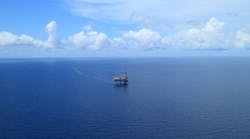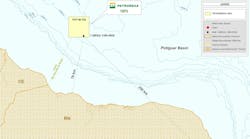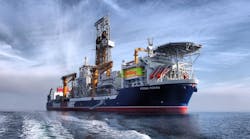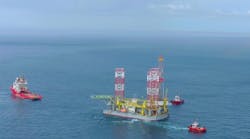Bruce Miller
ODS-Petrodata
Orders for new mobile offshore drilling units (MODUs) are surging. The upswing began in October 2010 with orders for a total of five jackup rigs placed by established drilling contractors. At that point, the price of West Texas Intermediate crude was 9% higher than in June 2010, and was on its way to an almost 20% increase by the end of the year. The combined effects of higher than expected crude oil prices, operators preferring newer, more efficient drilling units, and some degree of perceived stabilization in the global financial markets have propelled 2011 to become a record year in terms of the estimated total value of MODUs ordered with six months yet to go in the year.
Market overview
The downturn in demand that began in late 2008 caused concern. This was especially so since the downturn coincided with the arrival of a number of rigs that had been ordered in 2005 and 2006. This combination of events led to a rapid decline in working utilization – the most rigorous indicator of the health of the offshore drilling market. Deliveries continued, raising the total number from 588 in January 2006 to 653 in January 2009. By January 2010, the total numbers of MODUs had reached 692, although orders for new rigs had completely dried up by then. From January 2006 until January 2010, the fleet increased by 20%, with more units still under construction.
What became apparent with the influx of the new rigs was the impact of enhanced technology on the MODU market. The newer rigs, which in almost all cases have considerably higher specifications and capabilities than the bulk of the existing fleet, were finding work, even in the oversupplied market at that time, and pushing the older less capable rigs to the sidelines. This trend was especially apparent in the jackup market but was also the case, to a lesser degree, in the floating rig and tender-assist markets. The difference in marketability and day rates between the older and the newer rigs became pronounced during 2010, and in late 2010 to a new building cycle got underway.
Continuing new orders
The estimated capex for newbuild rigs recovered from a low of $2.7 billion in 2009, to $24.7 billion year to date in 2011, a figure that already exceeds the previous record set in 2007. What is causing this huge upswing? Apparently a feeling that today's prices for state of the art rigs, which are considerably lower than those seen just three years ago, are a temporary phenomenon. In 2011 alone, orders have been orders placed for 27 high-specification ultra-deepwater drillships and 29 jackup rigs. Surprisingly, only two semisubmersibles orders have been placed in 2011, and these were for Sevan's cylindrical units rather than for more conventional rigs. Tender assist rigs have seen four orders placed this year, in addition to the two rigs currently on order or under construction. This series of orders will raise the tender assist fleet from the current 32 to 38 by the end of 2013.
In terms of expenditure the focus clearly remains on drillship orders, which in 2011 accounted for $16.58 billion of the estimated total. Roughly one fourth, $4.64 billion, will come from by Sete Brasil, which ordered seven drillships to be built and operated in Brazil for Petrobras. Petrobras reports plans to tender for another 21 deepwater drilling rigs also to be constructed in Brazil.
Impact on day rates
Since 2005, the industry has placed more orders than at any period since the 1970s and the question becomes: Will there be enough demand for these rigs to keep them working at attractive day rates?
All day rates suffered with the decline in the price of crude oil that started in mid-2008. However day rates for floating rigs have more or less stabilized since early 2010 and have even increased for deepwater floaters. Although still far from the peak in 2008, day rates for these rigs are at healthy levels compared to prior to 2006, and apparently still provide a sufficiently good rate of return for rig owners to expand their fleets.
For jackup rigs in the selected markets the day rates have fallen quite a bit, but the rates are for all jackups. The newer or premium rigs earn a substantial day rate incentive over the older commodity type rigs.
Rates for the US Gulf of Mexico jackup market, which is predominantly driven by natural gas prices, peaked in early 2006, and the continuing weakness since then reflects low gas prices and competition from onshore shale plays where gas can be cheaper to find and develop.
Trying to predict where day rates will go is no easier than trying to forecast where oil prices are headed and of course these two are closely related, but contractors appear convinced that rates will at least stay near current levels with increases a distinct possibility.
Conclusion
Are drilling contractors building too many rigs? Perhaps in terms of the numbers involved, except the rigs that are being built and delivered seem to be the rigs the operators prefer, which means that the new rigs are working at the expense of the less capable units. Currently there are 166 drilling rigs of all types – either hot-stacked, warm-stacked, or cold-stacked – in essence out of the market at least temporarily. Of these, only seven are less than 10 years old, and these seven rigs are hot-stacked – the highest state of readiness – and four of them have their next contract in hand. As long as day rates for new rigs justify their construction, the present building cycle appears likely to continue.
About the Author
Bruce Miller is a senior consultant in ODS-Petrodata's Houston office.
Offshore Articles Archives
View Oil and Gas Articles on PennEnergy.com






